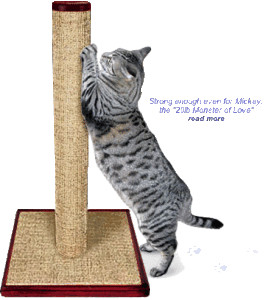The Desert Lynx Breed
The Desert Lynx cat is a unique and beautiful animal and requires a well-informed owner. Please read about the origin and nature of this lovely breed. After reading, if you feel you might be a good fit as a Desert Lynx owner, please proceed to our Interest Questionaire.
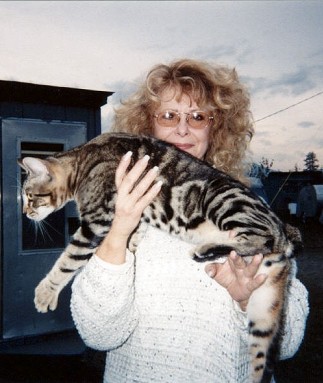
The Desert Lynx was developed by Arlene Magrino in the 1990s in response to a flood of pet owners looking for large exotic domestic cats. People would often end up adopting a Bengal, Bobcat or Lynx kitten and then have to give them up when they discovered that these wild breeds were not suited to indoor living as domestic pets and could be dangerous to live with as adults. Arlene was saddened to see so many beautiful and elegant animals in shelters, unable to live in the wild or as pets. She decided to create a breed of cat that had the characteristics of the wild breeds but with the gentle temperament of a house cat.
The Desert Lynx Breed draws from the bloodlines of the Maine Coon Cat, Bobcat, Pixie Bob and Manx. The breed is now strong and healthy with good bloodlines. The cats are bred in small litters and raised with love and attention. Each cat in the litter is different; you will find no inbreeding here. The cats are playful and affectionate and often have a personality more like a dog, playing fetch and coming when called.
Should I declaw?
I do not believe in declawing any cat…To accomplish the declawing the vet must amputate the entire first digit of each toe. It is cruel, painful and inhumane. In most cats it will turn them into biters, as it is their only means of self defense.In the Desert Lynx breed, declawing will turn them into biters. This can also cause arthritis in later years as well as permanent nerve damage.It impairs their quality of life; they can’t scratch an itch. If you intend to declaw, then this is not the breed for you.
Alternative to Declawing
I raise all of my kittens on a rough sisal rope scratching post. With the sisal rope they can feel the difference with their claws between the carpet on the floor and the fabric on the furniture. If you give them a carpet covered scratching post it feels the same to them. Be sure to get sisal, they love it.
My kittens play soft pawed, and will only use their claws in self defense if they are being hurt.
You can also check out this site written by a Veterinarian;
The Desert Lynx Cat is an Indoor Cat
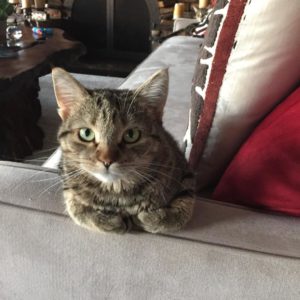
The Desert Lynx is a people-loving cat. They want to be with their people. Going outside should only be done while with you. They can be taught to walk on a harness. Outdoor cats only live for around 5 to 7 years if they are lucky, while a indoor cat will live well into their teens.
If the Desert Lynx is left outdoors with out you they might have a tendency to wander off to find a new home. They are very beautiful and friendly so people will pick them up and take them home with them. If you do not want to lose your cat to someone else, have them hit by a car, poisoned by people who do not like cats, then I highly recommend you do not let them out. This is a indoor cat.
The Highland Lynx vs. the Desert Lynx
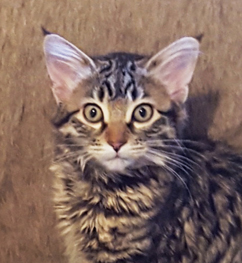

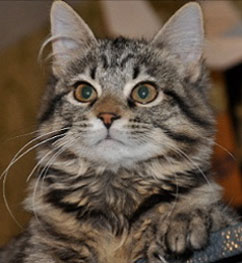
I would like to explain the difference between the Highland Lynx and the true original Desert Lynx.
Not every cat that looks like a Desert Lynx is a true Desert Lynx, with the beauty and temperament of the breed. Sometimes someone will claim to have a Desert Lynx when it is really a Highland Lynx. Here’s how that can happen:
In approximately 1996 a man named Joe Childers, owner of Timberline Cattery and the Rare & Exotic Feline Registry ( REFR) wanted to develop a new breed of cat with folded ears. He took the Desert Lynx and bred it with a Scottish Fold cat. That is where the name “Highland” came from, the Scottish highlands. The kittens with folded ears he placed in his registry ( REFR) ( Rare & Exotic Feline Registry) as a Highland Lynx, the kittens with straight ears he threw back in his registry and called them Desert Lynx. Any breeder will tell you that this is not an ethical practice. They should not have been registered as a pure bred Desert Lynx but a mixed breed and called some thing else other than a Desert Lynx as they no longer meet the criteria or rules of the Desert Lynx standard. This is the reason standards are set and must be fallowed in any breed.
Joe Childers went on to mix in the British Fold, Bengal, Calico’s American Folds, and so forth to develop the Highland Lynx. He did not deem any of these kittens right for his new breed (whether color, straight ears, etc.) they were again put in his registry as Desert Lynx. Again this is against the rules & why standards are important. Those resulting kittens whether straight eared or curled should have been given a new breed name with each additional breed he mixed in. Instead he broke the rules of the original Desert Lynx standard. Evidently he finally settled on the mixture of Jungle Curl along with whatever throw-away mixture he had developed over the years along the way and registered them as Desert Lynx, while developing his Highland Lynx breed. None of the breeds he used are excepted with in the true original Desert Lynx breed standard.
To put it in layman’s terms, you can not breed a Boxer with a Doberman and then register the ones that look like a Boxer with AKC as a pure bred Boxer dog. It is not, it is a mixed breed, the same way that the pups that may look like a Doberman can not be registered as a Doberman. To keep breeding different dog breeds with one of the mixes only further dilutes the original breed. If you then take these mixed breed pups and want to develop a new breed, you must then call it a new breed name, not sold as a Doberman or a Boxer. New rules and a new standard should be developed to except the new breed and perhaps called a Boxermen and drop the original breed name of Doberman or Boxer.
The temperament and personality of a true original Desert Lynx is vastly different than what has been developed by this unethical practice. The original breeds used to develop the true Desert Lynx were chosen to not only have the look of the bobcat, but when combined, have the wonderful dog like personality. The Desert Lynx breed has a standard. This standard was made 20+ years ago by ethical breeders and stands the same today with The International Desert Lynx Cat Association. None of the breeds used in the development of the Highland Lynx are allowed in the Desert Lynx breed. None of the breeds used to develop the Highland Lynx have the personality of a true Desert Lynx. What should have been done by Joe Childers while developing his new Highland Lynx breed is to have registered the kittens with straight ears as straight eared Highland Lynx, or given a new breed name, not register them as a Desert Lynx. The real Desert Lynx is registered with IPCBA, they are a ethical registry that verify the breed as to the standard created for it. Thus insuring that people get what they pay for and are not deceived.
So after many years and so many different breeds used to develop the Highland lynx, what other breeders are calling and selling as a Desert Lynx, is no longer anything like the original breed. I know that some breeders may be unaware of the fact that they do not have a real Desert Lynx, or even what the original standard rules are and were, so they continue to sell mixed breed kittens bred to Jungle Curl with straight ears as a Desert Lynx.
He also had many different breed names for kittens born to one litter. You can not make a breeding of a Poodle with a Lab and then have the puppies from that litter be one poodle, one Beagle, and 2 Labs, and a Pug! They are all Poodle/Lab mix or Laberdoodles.
Don’t be fooled, ask before you buy if the kitten is registered with the IPCBA or with REFR. If registered with REFR it is not a true Desert Lynx, it’s someones straight eared Highland Lynx mix … marketed as Desert Lynx.

